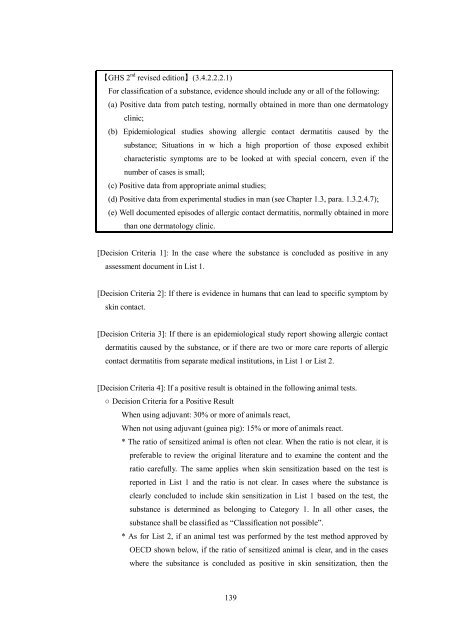GHS Classification Guidance for the Japanese Government
GHS Classification Guidance for the Japanese Government
GHS Classification Guidance for the Japanese Government
Create successful ePaper yourself
Turn your PDF publications into a flip-book with our unique Google optimized e-Paper software.
【<strong>GHS</strong> 2 nd revised edition】(3.4.2.2.2.1)<br />
For classification of a substance, evidence should include any or all of <strong>the</strong> following:<br />
(a) Positive data from patch testing, normally obtained in more than one dermatology<br />
clinic;<br />
(b) Epidemiological studies showing allergic contact dermatitis caused by <strong>the</strong><br />
substance; Situations in w hich a high proportion of those exposed exhibit<br />
characteristic symptoms are to be looked at with special concern, even if <strong>the</strong><br />
number of cases is small;<br />
(c) Positive data from appropriate animal studies;<br />
(d) Positive data from experimental studies in man (see Chapter 1.3, para. 1.3.2.4.7);<br />
(e) Well documented episodes of allergic contact dermatitis, normally obtained in more<br />
than one dermatology clinic.<br />
[Decision Criteria 1]: In <strong>the</strong> case where <strong>the</strong> substance is concluded as positive in any<br />
assessment document in List 1.<br />
[Decision Criteria 2]: If <strong>the</strong>re is evidence in humans that can lead to specific symptom by<br />
skin contact.<br />
[Decision Criteria 3]: If <strong>the</strong>re is an epidemiological study report showing allergic contact<br />
dermatitis caused by <strong>the</strong> substance, or if <strong>the</strong>re are two or more care reports of allergic<br />
contact dermatitis from separate medical institutions, in List 1 or List 2.<br />
[Decision Criteria 4]: If a positive result is obtained in <strong>the</strong> following animal tests.<br />
○ Decision Criteria <strong>for</strong> a Positive Result<br />
When using adjuvant: 30% or more of animals react,<br />
When not using adjuvant (guinea pig): 15% or more of animals react.<br />
* The ratio of sensitized animal is often not clear. When <strong>the</strong> ratio is not clear, it is<br />
preferable to review <strong>the</strong> original literature and to examine <strong>the</strong> content and <strong>the</strong><br />
ratio carefully. The same applies when skin sensitization based on <strong>the</strong> test is<br />
reported in List 1 and <strong>the</strong> ratio is not clear. In cases where <strong>the</strong> substance is<br />
clearly concluded to include skin sensitization in List 1 based on <strong>the</strong> test, <strong>the</strong><br />
substance is determined as belonging to Category 1. In all o<strong>the</strong>r cases, <strong>the</strong><br />
substance shall be classified as “<strong>Classification</strong> not possible”.<br />
* As <strong>for</strong> List 2, if an animal test was per<strong>for</strong>med by <strong>the</strong> test method approved by<br />
OECD shown below, if <strong>the</strong> ratio of sensitized animal is clear, and in <strong>the</strong> cases<br />
where <strong>the</strong> subsitance is concluded as positive in skin sensitization, <strong>the</strong>n <strong>the</strong><br />
139
















